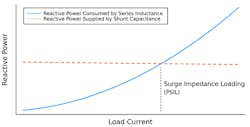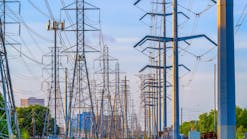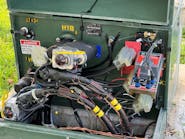It is primarily the difference in voltage angle that drives real power flow from one bus to the other.
Further, it is possible to derive an expression in which the magnitude of complex power is shown as some fraction of the surge impedance loading. Equation 1 is conceptual, but shows that the normalized complex power magnitude has real power and reactive power components that are each functions of both line length and voltage phase angle difference. In detailed form, the equation would include parameters associated with wave characteristics and dielectric material properties:
(Eq. 1)
where P1 and Q 1 are the sending end of real and reactive components of the complex power. At the surge impedance loading, there is no reactive power, and the real power can be written as follows:
(Eq. 2)
Both real and reactive power contribute to the current at the input to the line. Hence, for conditions in which Eq. 1 is greater than Eq. 2, the real power transmitted will be less because excess reactive power of the cable (which counts against thermal limits) is exported to the rest of the power system.
To determine line length limits, the constant contour values of Eq. 1 and Eq. 2 can be plotted as functions of both ∆θ and line length. More specifically, the constant values represent specific rated power flow as a fraction of the surge impedance loading. Different underground transmission lines will have thermal limits that are different percentages of their respective surge impedance loading.
Contour plots of the total complex power magnitude (that is, Eq. 1) in red and real power (that is, Eq. 2) in dashed black are plotted in the graph on the next page. One well-known characteristic of cables easily can be discerned from this graph. For zero real power transferred (that is, phase angle difference equal to zero), the maximum allowed complex power magnitude at the line input (in this case, all reactive power) increases linearly as the line length increases. This is consistent with the idea that capacitive current is larger for longer line lengths when there is no real power transfer (for example, no load and no voltage difference between the generators).
Once the fraction of rated cable current to surge impedance loading is determined, the thermally safe operating conditions for the cable are enclosed by the region to the left of the corresponding contour. For example, if the cable thermal rating is 20% of the surge impedance limit, the only portion of the plot that corresponds to allowable operation is to the left of the 20% contour in the graph (solid red contour lines).
It is important to note that even the no-load case (that is, assumes sources are connected to both ends of the cable and each absorbs the same amount of reactive power. If a cable is unloaded but energized from only one end, the theoretical maximum line length would be about half that indicated in the figure. In such a situation, it also is important to consider the steady-state voltage at the open end of the cable.
Some Examples
In this section, maximum line lengths are determined using a single-phase representation of commercially available 1500-kcmil cross-linked polyethylene (XLPE) cable designed for several different voltages. The hard length limit is determined by finding the maximum length for the no-load case (that is, . The practical length limit is the longest length for which the total power and real power are approximately equal. Lengths longer than the stated practical length limit could be used but would have to be derated for real power transfer. Again, it should be emphasized the limits derived here are for lines between voltage buses with equal voltage amplitude (that is, the same reactive power is exported at each end of the cable). Limits for other situations may be smaller. (See Table 1) It is clear from the table the practical use of underground cable is limited to lengths less than the theoretical hard limit. Further, the higher the voltage, the shorter the practical length limit.
Maximizing Length
Options for mitigating line length constraints are few. A cooling system could be used to raise the thermal limits of underground lines. However, this would require additional infrastructure and add substantially to the cost of underground transmission lines. Reactive compensation distributed at intermediate points along the line could be used to reduce that portion of the cable ampacity used up by reactive power flow. This could be done using shunt reactors, although the amount of compensation needed would depend on the load required. Furthermore, using shunt reactors could cause other operational issues, such as unintended resonances. High-voltage shunt reactors are costly, often require a small substation and present switching challenges that require special-purpose circuit breakers designed to interrupt inductive currents.
High-voltage direct-current (HVDC) could be used since there is no reactive power at dc. Note also the length of any transmission line as a fraction of wavelength becomes zero in this case. In fact, HVDC transmission lines are used exclusively for long undersea connections for which no ac system would be possible. However, dc transmission lines require both special cable and costly ac-dc converter terminals at each end.
Fundamental Differences
Fundamental differences exist between underground and high-voltage ac transmission lines because of their topology and heat-transfer characteristics. For underground lines, these differences result in length limits that are more restrictive for higher voltages. The same limits do not apply to overhead lines because they can be operated at or near surge impedance loading. As a result, replacing long ac overhead with long ac underground high-voltage transmission lines presents
major challenges derivable from fundamental physics.
The approach discussed in this article for determining maximum ac cable length is general and can provide insight into hard and practical length limits. The analysis suggests that, from a physics perspective, maximizing power flow for a given underground cable length is not necessarily achieved with the maximum voltage, as is often the case with overhead lines.
For More Information
Those who want to learn more about the theory behind this article can consult a background paper at www.electricutilitytools.com/education/ugtransmission. A free calculator also is available at www.electricutilitytools.com/calculators. This calculator allows estimation of maximum theoretical and practical ac cable lengths using detailed three-phase-based computation.
Download the full pdf of this article, which includes the inline equations and diagrams.
Robert G. Olsen ([email protected]) is professor emeritus in the School of Electrical Engineering and Computer Science at Washington State University. He received his Ph.D. and MSEE degrees from the University of Colorado Boulder in 1970 and 1974, respectively, and his BSEE degree from Rutgers University in 1968. He has been with Washington State University since 1973. His other positions included senior scientist with the Westinghouse Georesearch Laboratory in Colorado; NSF faculty fellow with GTE Laboratories in Massachusetts; a visiting scientist with ABB corporate research in Sweden and the Electric Power Research Institute (EPRI) in California; and a visiting professor with the Technical University of Denmark. His work has been featured in approximately 250 refereed journals and conferences. He is one of the authors of the EPRI AC Transmission Line Reference Book — 200 kV and Above (EPRI, 2005). Olsen is an honorary life member of the IEEE Electromagnetic Compatibility (EMC) Society. He also is a past U.S. National Committee representative of CIGRE Study Committee 36 (EMC) and a past chair of IEEE Power & Energy Society ac fields and corona effects working groups. In addition, he is a past associate editor for the IEEE Transactions on Electromagnetic Compatibility and Radio Science.
Jon T. Leman ([email protected]) is an electrical engineer with over 20 years of experience in AC and DC overhead and underground transmission line design and power system studies. He is currently the owner and principal engineer of Power Electromagnetics Consulting, PLLC and a partner at Electric Utility Design Tools, LLC, a provider of transmission line design software. Leman earned his Ph.D. degree in electrical and computer engineering from Washington State University and his MSEE and BSEE degrees from the University of Idaho. His technical interests include electromagnetics, power system transients, equipment failure investigation, numerical methods, insulation coordination, and power system planning. The focus of his doctoral research was the application of electromagnetics to optimize high-voltage transmission line design. He is a member of CIGRE and a senior member of IEEE.





